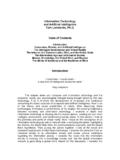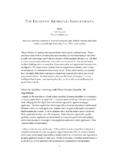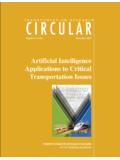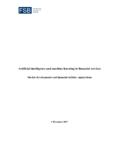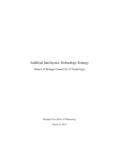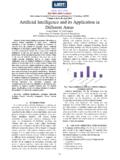Transcription of Artificial Intelligence and the Modern Productivity ...
1 Artificial Intelligence and the Modern Productivity Paradox: A Clash of Expectations and Statistics (This is a minor revision of NBER Working Paper No. 24001) Erik Brynjolfsson, MIT Sloan School of Management and NBER Daniel Rock, MIT Sloan School of Management Chad Syverson, University of Chicago Booth School of Business and NBER October 2017; Revised December 2017 Abstract. We live in an age of paradox. Systems using Artificial Intelligence match or surpass human-level performance in more and more domains, leveraging rapid advances in other technologies and driving soaring stock prices. Yet measured Productivity growth has declined by half over the past decade, and real income has stagnated since the late 1990s for a majority of Americans.
2 We describe four potential explanations for this clash of expectations and statistics: false hopes, mismeasurement, redistribution and implementation lags. While a case can be made for each explanation, we argue that lags have likely been the biggest contributor to the paradox. The most impressive capabilities of AI, particularly those based on machine learning, have not yet diffused widely. More importantly, like other general purpose technologies, their full effects won t be realized until waves of complementary innovations are developed and implemented. The adjustment costs, organizational changes, and new skills needed for successful AI can be modeled as a kind of intangible capital.
3 A portion of the value of this intangible capital is already reflected in the market value of firms. However, going forward, national statistics could fail to measure the full benefits of the new technologies and some may even have the wrong sign. Acknowledgements: We thank Eliot Abrams, Ajay Agrawal, David Autor, Seth Benzell, Joshua Gans, Avi Goldfarb, Austan Goolsbee, Guillaume Saint-Jacques, Andrea Meyer, Manuel Tratjenberg, and numerous participants at the NBER Workshop on AI and Economics in September, 2017. In particular, Rebecca Henderson provided detailed and very helpful comments on an earlier draft and Larry Summers suggested the analogy to the J-Curve. Generous funding for this research was provided in part by the MIT Initiative on the Digital Economy.
4 Contact information: Brynjolfsson: MIT Sloan School, E62-414, 100 Main Street, Cambridge, MA 02142; Rock: 100 Main Street, Cambridge, MA 02142; Syverson: University of Chicago Booth School of Business, 5807 S. Woodlawn Ave., Chicago, IL 60637. 1 The discussion around the recent patterns in aggregate Productivity growth highlights a seeming contradiction. On the one hand, there are astonishing e xamples of potentially transformative new technologies that could greatly increase Productivity and economic welfare ( see Brynjolfsson and McAfee, 2014). There are some early concrete signs of these technologies promise, recent leaps in Artificial Intelligence (AI) performance being the most prominent example.
5 However, at the same time, measured Productivity growth over the past decade has slowed significantly. This deceleration is large, cutting Productivity growth by half or more in the decade preceding the slowdown. It is also widespread, having occurred throughout the Organization for Economic Co-operation and Development (OECD) and, more recently, among many large emerging economies as well (Syverson, 2017).1 We thus appear to be facing a redux of the Solow (1987) Paradox: we see transformative new technologies everywhere but in the Productivity statistics. In this paper, we review the evidence and explanations for the Modern Productivity paradox and propose a resolution. Namely, there is no inherent inconsistency between forward-looking technological optimism and backward-looking disappointment.
6 Both can simultaneously exist. Indeed, there are good conceptual reasons to expect them to simultaneously exist when the economy undergoes the kind of restructuring associated with transformative technologies. In essence, the forecasters of future company wealth and the measurers of historical economic performance show the greatest disagreement during times of technological change. In this paper we argue and present some evidence that the economy is in such a period now. Sources of Technological Optimism Paul Polman, Unilever s CEO, recently claimed that The speed of innovation has never been faster. Similarly, Bill Gates, Microsoft s co-founder, observes that Innovation is moving at a scarily fast pace.
7 Vinod Khosla of Khosla Ventures sees the beginnings [a] rapid acceleration in the next 10, 15, 20 years. Eric Schmidt of Alphabet Inc., believes 1 A parallel, yet more pessimistically oriented debate about potential technological progress is the active discussion about robots taking jobs from more and more workers ( , Brynjolfsson and McAfee, 2011; Acemoglu and Restrepo, 2017; Bessen, 2017; Autor and Salomons, 2017). 2 we re the age of abundance [and] during the age of abundance, we re going to see a new the age of Intelligence . 2 Assertions like these are especially common among technology leaders and venture capitalists.
8 In part, these assertions reflect the continuing progress of IT in many areas, from core technology advances like further doublings of basic computer power (but from ever larger bases) to successful investment in the essential complementary innovations like cloud infrastructure and new service-based business models. But the bigger source of optimism is the wave of recent improvements in AI, especially machine learning. Machine learning represents a fundamental change from the first wave of computerization. Historically, most computer programs were created by meticulously codifying human knowledge, mapping inputs to outputs as prescribed by the programmers. In contrast, machine-learning systems use categories of general algorithms ( , neural networks) to figure out relevant mappings on their own, typically by being fed very large sample data sets.
9 By u sing these machine-learning methods that leverage the growth in total data and data processing resources, machines have made impressive gains in perception and cognition, two essential skills for most types of human work. For instance, error rates in labeling the content of photos on ImageNet, a dataset of over 10 million images, have fallen from over 30 percent in 2010 to less than 5 percent in 2016 and most recently as low as percent with SE-ResNet152 in the ILSVRC2017 competition (see Figure 1).3 Error rates in voice recognition on the Switchboard speech recording corpus, often used to measure progress in speech recognition, have decreased to percent from percent over the past year (Saon et al.)
10 , 2017). The 5 percent threshold is important, because that is roughly the performance of humans on each of these tasks on the same test data. 2 #2045:_The_Singularity 3 ImageNet includes labels for each image, originally provided by humans. For instance, there are 339,000 labeled as flowers, 1,001,000 as food, 188,000 as fruit, 137,000 as fungus, and so on. 3 Although not at the level of professional human performance yet, Facebook s AI research team recently improved upon the best machine language translation algorithms available using convolutional neural net sequence prediction techniques (Gehring et al., 2017). Deep learning techniques have also been combined with reinforcement learning, a powerful set of techniques used to generate control and action systems whereby autonomous agents are trained to take actions given an environment state to maximize future rewards.










